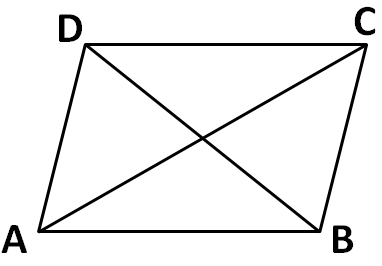
What is the symbol of diagonal?
Answer
535.8k+ views
Hint: A diagonal in geometry is defined as the line joining the two opposite vertices of a polygon. A polygon is defined as the two dimensional shape having three or more vertices. But for opposite vertices, a diagonal is defined only for the polygons having four or more sides. The symbol for the diagonal is chosen in accordance with its general orientation.
Complete step by step solution:
We know that the diagonal is a line which is defined for the polygons in geometry. Geometrically, it is defined as the line which connects the two opposite vertices of a polygon.
Now, we know that the polygon is a two dimensional figure and this term can be used for all of the closed figures which have a minimum of three sides. We know that the number of sides of a closed shape or a figure is equal to the number of vertices. And for opposite vertices, there must be a minimum of four vertices. Therefore, the definition of a diagonal is valid only for the polygons having a number of sides equal to four or more. So the three sided polygon, known as the triangle, is excluded from this definition.
Now, let us consider a parallelogram, which is a four sided polygon, as shown in the below figure.

In the above parallelogram ABCD we can see that there are two diagonals AB and CD. Both of the two diagonals have a slanted orientation. Since the diagonals are generally slanted, a slanted symbol $/$ is used to denote diagonals.
Hence, the symbol $/$ is used for a diagonal.
Note: The symbol of a diagonal is a slanted line, but it does not mean that a diagonal must necessarily be slanted. A diagonal can be slanted, vertical or horizontal. We can also note that the symbol $/$ is for the division operator too. But it is also used to represent diagonals in geometry.
Complete step by step solution:
We know that the diagonal is a line which is defined for the polygons in geometry. Geometrically, it is defined as the line which connects the two opposite vertices of a polygon.
Now, we know that the polygon is a two dimensional figure and this term can be used for all of the closed figures which have a minimum of three sides. We know that the number of sides of a closed shape or a figure is equal to the number of vertices. And for opposite vertices, there must be a minimum of four vertices. Therefore, the definition of a diagonal is valid only for the polygons having a number of sides equal to four or more. So the three sided polygon, known as the triangle, is excluded from this definition.
Now, let us consider a parallelogram, which is a four sided polygon, as shown in the below figure.

In the above parallelogram ABCD we can see that there are two diagonals AB and CD. Both of the two diagonals have a slanted orientation. Since the diagonals are generally slanted, a slanted symbol $/$ is used to denote diagonals.
Hence, the symbol $/$ is used for a diagonal.
Note: The symbol of a diagonal is a slanted line, but it does not mean that a diagonal must necessarily be slanted. A diagonal can be slanted, vertical or horizontal. We can also note that the symbol $/$ is for the division operator too. But it is also used to represent diagonals in geometry.
Recently Updated Pages
You are awaiting your class 10th results Meanwhile class 7 english CBSE

Master Class 7 Social Science: Engaging Questions & Answers for Success

Master Class 7 Science: Engaging Questions & Answers for Success

Class 7 Question and Answer - Your Ultimate Solutions Guide

Master Class 7 English: Engaging Questions & Answers for Success

Master Class 7 Maths: Engaging Questions & Answers for Success

Trending doubts
Full Form of IASDMIPSIFSIRSPOLICE class 7 social science CBSE

Convert 200 Million dollars in rupees class 7 maths CBSE

i What trees does Mr Wonka mention Which tree does class 7 english CBSE

What are the controls affecting the climate of Ind class 7 social science CBSE

Write a letter to the editor of the national daily class 7 english CBSE

Welcome speech for Christmas day celebration class 7 english CBSE





